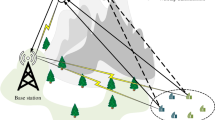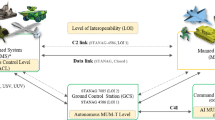Abstract
Unmanned aerial vehicles (UAVs) are considered to play vital roles in the Sixth Generation (6G) networks and beyond. However, the confidentiality of UAV communication is sensitive to security threats owing to the broadcast nature and principal line-of-sight channel conditions. This paper proposes a three-dimensional (3D) robust beamforming method for UAV systems in terms of physical layer security in order to improve secrecy performance. In particular, attempting to maximize the average secrecy rate (ASR) of the considered system, a precisely designed unsupervised artificial neural network based on Denoising AutoEncoder (DAE) is used to optimize the beamformer for confidential signal with the simultaneous existence of artificial noise (AN). Simulation results show that the proposed approach can achieve higher average secrecy and more focused beams than existing previous methods in the same scenarios.










Similar content being viewed by others
References
Jiang X, Sheng M, Zhao N, Xing C, Lu W, Wang X (2022) Green UAV communications for 6G: A survey. Chin J Aeronaut 35:19–34. https://doi.org/10.1016/j.cja.2021.04.025
Zhu L, Zhang J, Xiao Z, Cao X, Wu DO, Xia X-G (2019) 3-D Beamforming for flexible coverage in millimeter-wave UAV communications. IEEE Wirel Commun Lett 8:837–840. https://doi.org/10.1109/LWC.2019.2895597
Wang H-M, Zhang X (2019) Jiang, Jia-Cheng: UAV-involved wireless physical-layer secure communications: overview and research directions. IEEE Wirel Commun 26:32–39. https://doi.org/10.1109/MWC.001.1900045
Zhu L, Zhang J, Xiao Z, Cao X, Wu DO, Xia X-G (2020) Energy-efficient and secure air-to-ground communication with jittering UAV. IEEE Trans Veh Technol 69:3954–3967. https://doi.org/10.1109/TVT.2020.2971520
Li T, Zhang J, Obaidat MS, Lin C, Lin Y, Shen Y, Ma J (2022) Energy-efficient and secure communication toward UAV networks. IEEE Internet Things J 9:10061–10076. https://doi.org/10.1109/JIOT.2021.3118079
Sun X, Ng DWK, Ding Z, Xu Y, Zhong Z (2019) Physical layer security in UAV systems: Challenges and opportunities. IEEE Wirel Commun 26:40–47. https://doi.org/10.1109/MWC.001.1900028
Li Y, Zhang R, Zhang J, Yang L (2020) Cooperative jamming via spectrum sharing for secure UAV communications. IEEE Wirel Commun Lett 9:326–330. https://doi.org/10.1109/LWC.2019.2953725
Xiao Z, Zhu L, Liu Y, Yi P, Zhang R, Xia X-G, Schober R (2022) A survey on millimeter-wave beamforming enabled UAV communications and networking. IEEE Commun Surv Tutor 24:557–610. https://doi.org/10.1109/COMST.2021.3124512
Khisti A, Wornell GW (2010) Secure transmission with multiple antennas I: The MISOME wiretap channel. IEEE Trans Inf Theory 56:3088–3104. https://doi.org/10.1109/TIT.2010.2048445
Dong R, Wang B, Cao K (2021) Deep learning driven 3D robust beamforming for secure communication of UAV systems. IEEE Wirel Commun Lett 10:1643–1647. https://doi.org/10.1109/LWC.2021.3075996
Morocho-Cayamcela ME, Njoku JN, Park J, Lim W (2020) Learning to communicate with autoencoders: Rethinking wireless systems with deep learning. In: 2020 International Conference on Artificial Intelligence in Information and Communication (ICAIIC). IEEE, Japan, pp. 308–311. https://doi.org/10.1109/ICAIIC48513.2020.9065246
Wang C-X, Renzo MD, Stanczak S, Wang S, Larsson EG (2020) Artificial intelligence enabled wireless networking for 5G and beyond: Recent advances and future challenges. IEEE Wirel Commun 27:16–23. https://doi.org/10.1109/MWC.001.1900292
Iliev TB, Ivanova EP, Stoyanov IS, Mihaylov GY, Beloev IH (2021) Artificial intelligence in wireless communications - evolution towards 6G mobile networks. In: 2021 44th International Convention on Information, Communication and Electronic Technology (MIPRO). IEEE, Croatia, pp. 432–437. https://doi.org/10.23919/MIPRO52101.2021.9597147
Nguyen DC, Cheng P, Ding M, Lopez-Perez D, Pathirana PN, Li J, Seneviratne A, Li Y, Poor HV (2021) Artificial intelligence enabled wireless networking for 5G and beyond: Recent advances and future challenges. IEEE Commun Surv Tutor 23:553–595. https://doi.org/10.1109/COMST.2020.3024783
Wei L, Huang C, Alexandropoulos GC, Yuen C, Zhang Z, Debbah M (2021) Channel estimation for RIS-empowered multi-user MISO wireless communications. IEEE Trans Commun 69:4144–4157. https://doi.org/10.1109/TCOMM.2021.3063236
Vincent P, Hugo Larochelle YB, Manzagol PA (2008) Extracting and composing robust features with denoising autoencoders. In: Proceedings of the 25th international conference on machine learning, Finland, pp. 1096–1103. https://doi.org/10.1145/1390156.1390294
Dong G, Liao G, Liu H, Kuang G (2018) A review of the autoencoder and its variants: A comparative perspective from target recognition in synthetic-aperture radar images. IEEE Geosci Remote Sens Mag 6:44–68. https://doi.org/10.1109/MGRS.2018.2853555
Djork-Arn´e Clevert TU, Hochreiter S (2015) Fast and accurate deep network learning by exponential linear units (ELUs). In: Proceedings of the international conference on learning representations 2016, Puerto Rico, pp. 1–14. arXiv preprint arXiv:1511.07289
Deepa N (2021) A novel intervention method for aspect-based emotion using exponential linear unit (ELU) activation function in a deep neural network. In: 2021 5th international conference on intelligent computing and control systems (ICICCS), pp. 1671–1675. IEEE, India. https://doi.org/10.1109/ICICCS51141.2021.9432223
Urolagin S, Prema KV, Reddy NVS (2011) Generalization capability of artificial neural network incorporated with pruning method. Proceedings of The 2011 international conference on advanced computing, networking and security. Springer, India, pp. 171–178. https://doi.org/10.1109/CISCE52179.2021.9445927
Acknowledgements
This research was funded by Vingroup JSC and supported by the Postdoctoral Scholarship Programme of Vingroup Innovation Foundation (VINIF), Institute of Big Data, code VINIF.2022.STS.08. We would like to thank the anonymous reviewers for the valuable feedback provided throughout the revision process.
Author information
Authors and Affiliations
Corresponding author
Additional information
Publisher's Note
Springer Nature remains neutral with regard to jurisdictional claims in published maps and institutional affiliations.
Rights and permissions
Springer Nature or its licensor (e.g. a society or other partner) holds exclusive rights to this article under a publishing agreement with the author(s) or other rightsholder(s); author self-archiving of the accepted manuscript version of this article is solely governed by the terms of such publishing agreement and applicable law.
About this article
Cite this article
Pham-Quoc, C., Nguyen-Duy-Nhat, V., Le, M.T.P. et al. Robust 3D Beamforming for Secure UAV Communications by DAE. Mobile Netw Appl 28, 1197–1205 (2023). https://doi.org/10.1007/s11036-023-02130-w
Accepted:
Published:
Issue Date:
DOI: https://doi.org/10.1007/s11036-023-02130-w




